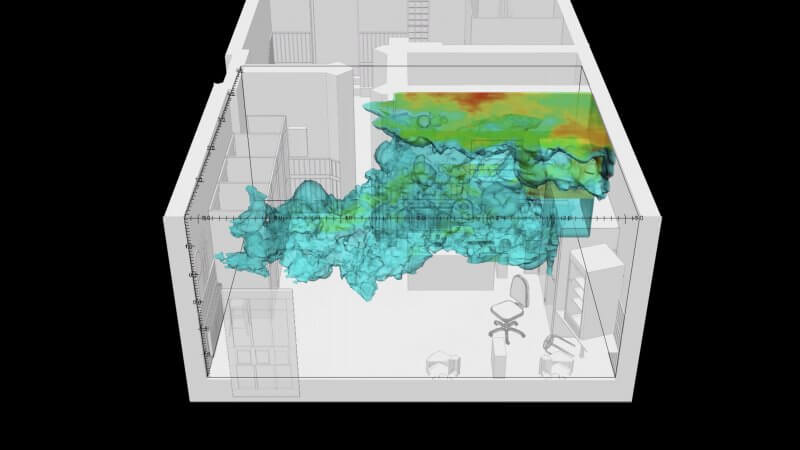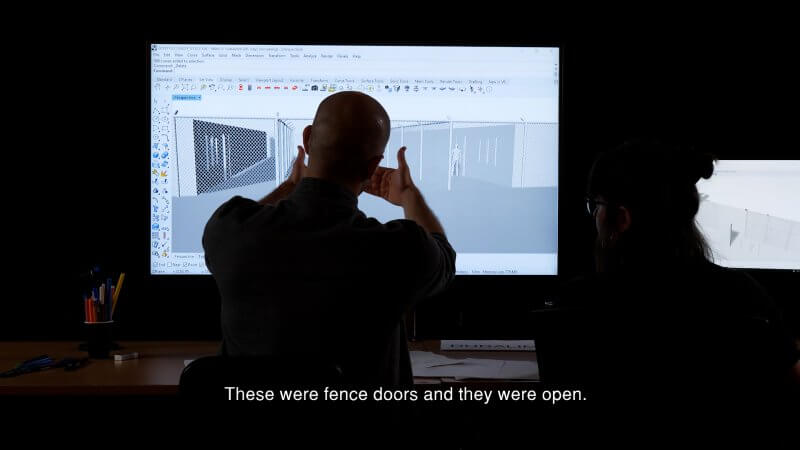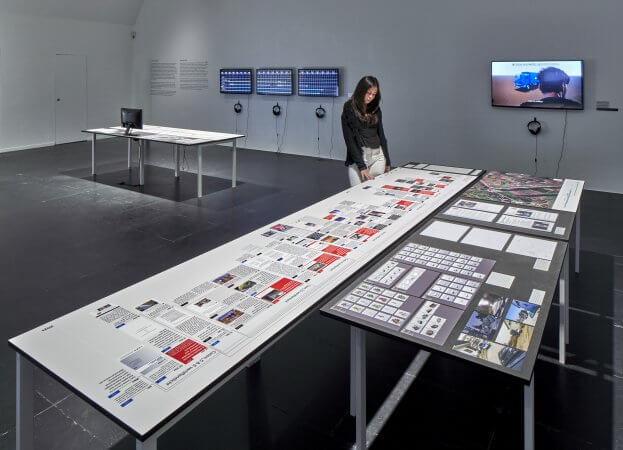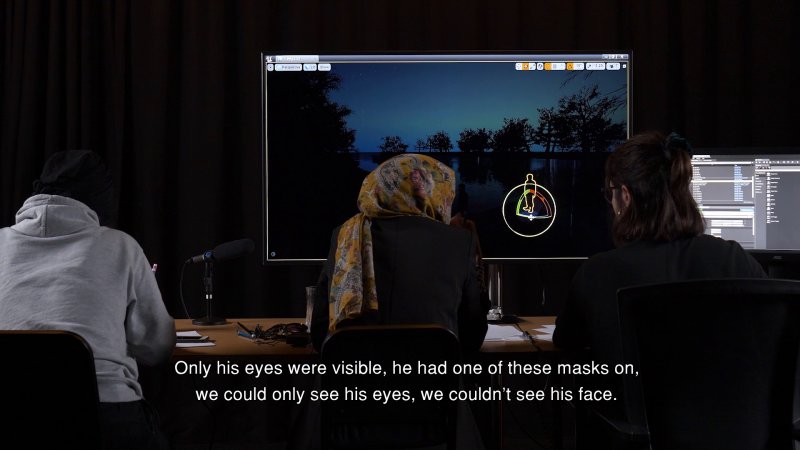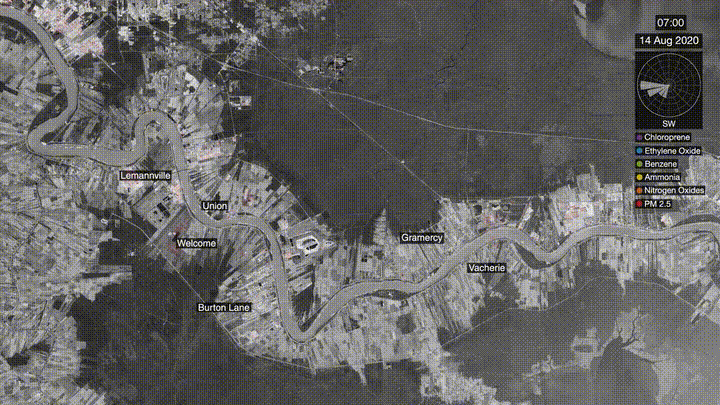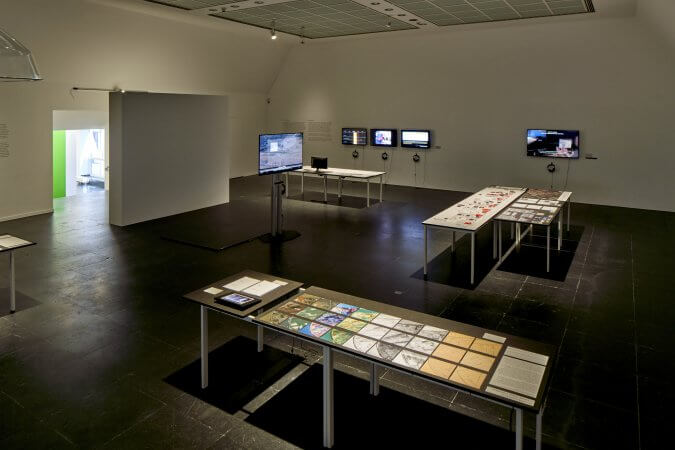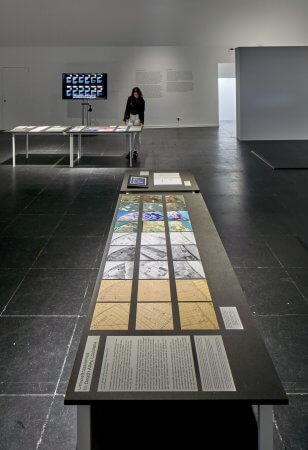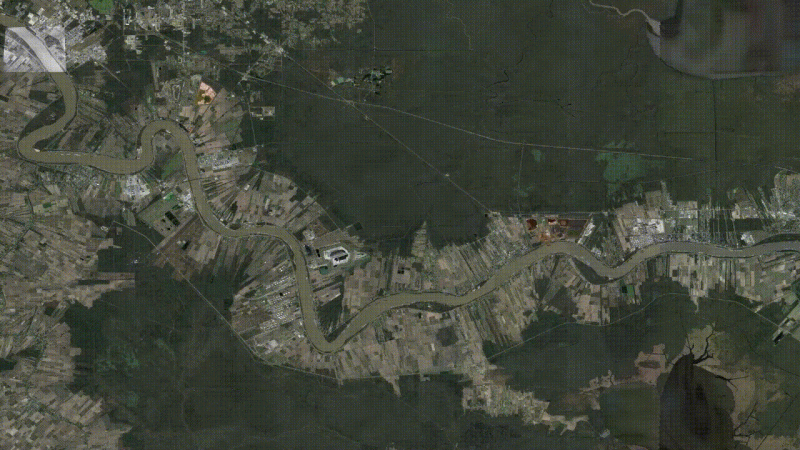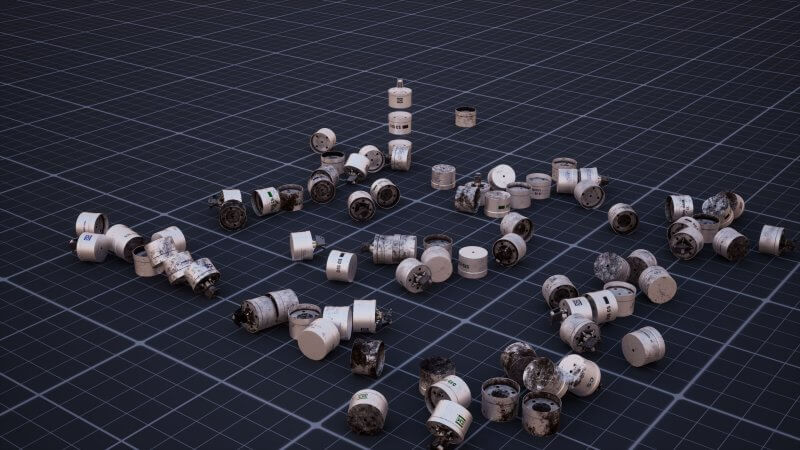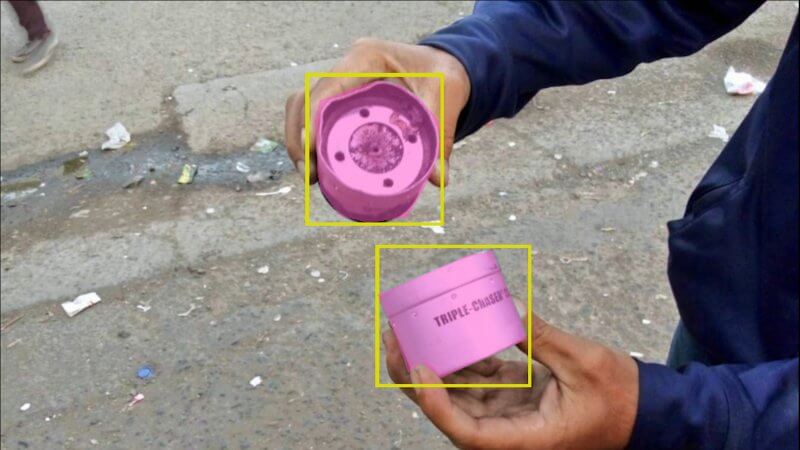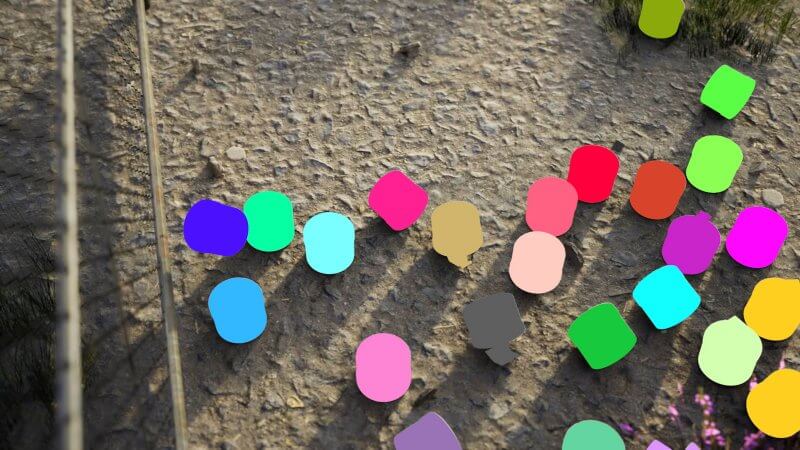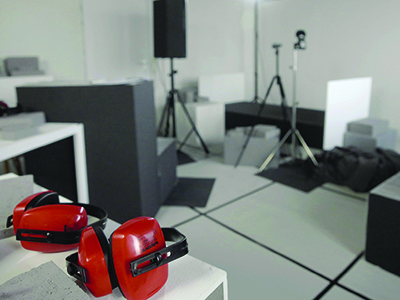Postscript: Counter-forensics
This room provides context for Forensic Architecture’s ongoing practice of ‘counter-forensics’.
Since 2010, Forensic Architecture (FA) has carried out more than 80 investigations around the world, and presented them in national and international courts, truth commissions, as well as in art and cultural institutions.
By inverting the direction of the ‘forensic gaze’, the agency seeks to delineate a field of action in which individuals and independent organisations at the forefront of struggle can detect and confront abuses of power. At the same time FA is committed to critically interrogating the legal, technological, media and political cultures in which its practice is embedded.
Forensis – the name of FA’s Berlin-based sister agency – is Latin for ‘pertaining to the forum’ and is the root of the term forensics. The Roman forum was a multidimensional space of negotiation and truth-finding in which humans and objects participated together in politics, law and the economy.
With the advent of modernity, the meaning of forensics shifted to refer increasingly to the domain of law, and particularly to the use of medicine in the courts. Today, forensics is central to the ways by which states police and govern their subjects. By returning to the wider concept of ‘forensis’, the agency seeks to unlock the potential of forensics as a counter-political practice.
Forensic Architecture, London & Forensis, Berlin
THE MURDER OF HALIT YOZGAT
In the early 2000s, the neo-Nazi group National Socialist Underground (NSU) spread terror throughout Germany’s migrant communities with a series of 10 racially motivated murders. After years of local anti-racist activism, in 2015 a people’s tribunal titled “Unravelling the NSU Complex” was formulated by activists, the families of the victims, and community members who thought the legal process was limited in its ability to address state and societal responsibility in these murders.
Unravelling the NSU Complex invited Forensic Architecture to investigate one of the murders, unique for having taken place while a German secret service agent, Andreas Temme, was present at the scene of the crime. On April 6, 2006, 21-year-old Halit Yozgat was murdered in his family-run internet café in Kassel. Within the café’s 77 square meters, an agent of the state, the killers, and the targeted migrants were all present. A reenactment of the murder within a life-size model of the internet café, undertaken in collaboration with HKW, demonstrated that the agent was giving false testimony when he said he did not see or hear the killing.
After being presented in the tribunal and having garnered attention within the context of contemporary art, with groups of German politicians attending to view the evidence, the exhibit was summoned for presentation at two parliamentary inquiries. Testifying to the difficulty of crossing disciplinary and institutional borders, art reviews referred to the exhibit as “evidence, not art,” while those accused and threatened by it (unsuccessfully) tried to disqualify it by calling it “art, not evidence.”
Commissioned by: Unravelling the NSU Complex, Initiative 6. April
Collaborators: Forensic Architecture, NSU-Komplex auflösen, Initiative 6. April, HKW, documenta 14, The Institute of Contemporary Arts (ICA)
Forensic Architecture: Eyal Weizman (Principal Investigator), Christina Varvia (Project Coordinator), Stefanos Levidis, Simone Rowat, Omar Ferwati, Nicholas Masterton, Yamen Albadin, Ortrun Bargholz, Eeva Sarlin, Bob Trafford, Franc Camps Febrer, Hana Rizvanolli, Sarah Nankivell, Chris Cobb Smith (Advisor), Lawrence Abu Hamdan (Advisor)
Unravelling the NSU Complex; Initiative 6. April team: Ayşe Güleç, Natascha Sadr Haghighian, Fritz Laszlo Weber, Sebastian Bodirsky, Markus Mohr, Serdar Kazak
Extended team: Cordula Hamschmidt/HKW, Khaled Abdulwahed, Cem Kayan, Vanina Vignal, Dr. Salvador Navarro-Martinez/Imperial College London, Grant Waters/Anderson Acoustics, Armament Research Services (ARES), Mihai Meirosu/Nvision Audio, Christopher Hupe/HKW, Frank Bubenwer, Gozen Atila, Mathias Zeiske/HKW, Norma Tiedemann, Başak Ertür
Presented to the German Parliamentary Inquiry (June 2017) and to the Hessen Parliamentary Inquiry (25 August 2017)
PUSHBACKS ACROSS THE EVROS/MERIÇ RIVER: SITUATED TESTIMONY
For years, migrants and refugees crossing the Greek/Turkish “land” border via the Evros/Meriç River have testified to being detained, beaten, and “pushed back” to Turkey by unidentified masked men, in full secrecy, and without being granted access to asylum procedures. Witnesses describe having their phones, documents, and possessions confiscated and often thrown into the river, suggesting an operation designed specifically to remove any potential evidence of human rights violations.
Further debilitating the documentation of pushbacks is the militarization of this border region, which makes access extremely difficult; a restricted “buffer zone” runs along both banks of the river. Detention centers and border-guard stations are often located within this buffer zone, keeping detained people out of sight and without access to legal support. The secrecy and obscurity of evidence enable the Greek and EU authorities systematically to deny any wrongdoing and refuse to investigate these reports.
In order to circumvent these limitations, Forensic Architecture employed the technique of “situated testimony” with two witnesses, Fady and Kuzey, both of whom had been pushed back multiple times across the river. Situated testimony is an interviewing methodology which uses 3D models of the scenes and environments in which traumatic events occurred to aid in the process of recollection. Together with the witnesses, we reconstructed the practice of pushbacks, corroborating the systematic and widespread nature of the operations, and helping to identify the sites and actors involved. On November 17, 2020, our work was included in the complaint against the Greek government that was submitted to the United Nations Human Rights Committee by HumanRights360 and Global Legal Action Network (GLAN) on behalf of Fady.
Collaborators: Forensic Architecture, HumanRights360, HIAS Greece, Global Legal Action Network (GLAN), Greek Council for Refugees
Witnesses: Fady, Kuzey (Pseudonym)
Forensic Architecture: Eyal Weizman (Principal Investigator), Christina Varvia (Researcher in Charge), Stefanos Levidis (Project Coordinator), Dimitra Andritsou, Kishan San, Alican Aktürk, Nour Abuzaid, Zac Ioannidis, Phevos Kororos-Simeonidis, Lachlan Kermode, Hanieh Fatouraee, Mhamad Safa, Ifor Duncan, Samaneh Moafi, Sarah Nankivell, Robert Trafford
Extended Team: Iason Arvanitakis, Giorgos Valsamis, Sofia Georgovassili, Baris Karadeniz, Katerina Polychroni, Fares Nidal, Jalal Barekzai, Odinn Ingibergsson
THE KILLING OF MUHAMMAD GULZAR
On March 4, 2020, reports emerged on social media of shootings and casualties of migrants attempting to cross the Greek/Turkish “land” border at the fenced area of the Kastanies-Pazarkule border station. The Greek authorities immediately denounced these claims as fake news. This happened a few days after the Turkish government opened its borders with Greece in an attempt to exert political pressure on the EU, and only two days after another person, Muhammad al-Arab, was shot dead at the Evros/Meriç Delta region.
In order to respond swiftly to the events, an investigative newsroom was set up at the initiative of Lighthouse Reports, which included Forensic Architecture, Bellingcat, and Der Spiegel, amongst other journalists and researchers. Together, we examined hundreds of videos and images, spoke to eyewitnesses, and collected documents in order to reconstruct the events of that day.
We established that live rounds were fired along the border, with seven people having sustained injuries, two of whom were identified as Mohamad Hantou and Zeeshan Omar. Muhammad Gulzar, a Pakistani citizen who until recently had lived in Greece, was killed. Our analysis showed that it is highly probable that the shots that killed Gulzar and wounded the remaining six casualties were fired from the Greek side of the border.
The evidence we produced was mobilized within various civil and political forums, including the EU’s LIBE Committee, and we were invited to testify as expert witnesses for the legal case that is investigating Gulzar’s killing. The Greek state continues to deny the use of live fire at the border, a position that mainstream Greek media has adopted resulting in a hostile climate of denial.
Collaborators Forensic Architecture, Bellingcat, Lighthouse Reports, DER SPIEGEL
Further reporting by: Pointer (KRO-NCRV), Sky News
Forensic Architecture: Christina Varvia (Researcher in Charge), Stefanos Levidis (Project Coordinator), Dimitra Andritsou, Kishan San, Nour Abuzaid, Lola Conte, Sarah Nankivell, Robert Trafford, Eyal Weizman
Extended team: Beck Audio Forensics, HumanRights360
Special thanks to Stephanie Walcott/Department of Forensic Science an der Virginia Commonwealth University, Planet Labs
ENVIRONMENTAL RACISM IN DEATH ALLEY, LOUISIANA
If toxic air is a monument to slavery, how do we take it down?
Around the world, monuments to slave masters declare defiant allegiance to white supremacy. State authorities are finally bowing to longstanding activist demands to ‘take ‘em down’. Yet as the monuments recede from vision, the structural legacy of settler colonialism and slavery remains intact. It pervades the air we breathe.
In the US state of Louisiana, along 85 miles of the Mississippi River between Baton Rouge and New Orleans, lies a region once called ‘Plantation Country’, now known as the ‘Petrochemical Corridor’. Over 200 (and counting) industrial plants occupy the fallow footprints of formerly slave-powered sugarcane plantations. Today, in the shadow of those plants, neighbouring communities – mostly historic ‘freetowns’ inhabited by the descendants of people enslaved on those same grounds – breathe some of the most toxic air in the US. They refer to their homeland as ‘Death Alley’.
As industry poisons their air, it crushes the remains of their ancestors. Across the ruined mosaic of plantations, hundreds of Black cemeteries face desecration by frenzied development.
Together with RISE St. James, Forensic Architecture has developed strategies to bring visibility to lethal chemical agents and recover traces of erased cemeteries before industry breaks ground.
Collaborators: Forensic Architecture; RISE St James; Center for Constitutional Rights (CCR); Center for International Environmental Law (CIEL); The Descendants Project; Earthworks; Healthy Gulf; Imperial College London; Louisiana Bucket Brigade; The Human Rights Advocacy Project (HRAP), Loyola New Orleans College of Law; The Ethel and Herman L. Midlo Center for New Orleans Studies; Louisiana Museum of African American History; Whitney Plantation Museum
Forensic Architecture: Imani Jacqueline Brown (Project Coordinator), Samaneh Moafi (Project Coordinator), Eyal Weizman, Sarah Nankivell, Dimitra Andritsou, Olukoye Akinkugbe, Omar Ferwati, Ariel Caine, Kishan San, Nicholas Masterton, Robert Trafford, Nour Abuzaid, Elizabeth Breiner, Sanjana Varghese, Ayana Enomoto-Hurst, Ana Lopez Sanchez-Vegazo, Caterina Selva, Jacob Bertilsson
Extended Team: Dr. Salvador Navarro-Martinez, Sam Blair
Special thanks to: Sharon Lavigne, August „AJ“ Gomez, Milton Cayette, Chasity White, Jo Banner, Joy Banner, Jordan Brewington, Leon A. Waters, Don Hunter, D. Ryan Gray, Devin Ngetich, Mary N. Mitchell, Ludovico Palmeri, Milo Daemgen, Bao Ngo, Bryan C. Lee, Jr., Paavo Hanninen, Jeremy Blum, Julie Dermansky, Tammie Mills, Alahna Moore, Stephanie Cooper
TRIPLE-CHASER
That art institutions are not only alternative and neutral venues for the display of evidence, but can also themselves be implicated in human rights violations, came to the fore when activists exposed the Vice Chair of the Whitney Museum’s board of trustees, Warren B. Kanders, as the owner of the Safariland Group—one of the world’s major manufacturers of tear gas. The online platform Hyperallergic was the first to publish Kanders’ involvement in the industry; soon after, the movement Decolonize This Place organized nine weeks of protests in the museum, while the group Working Artists and the Greater Economy (W.A.G.E.) invited artists to demand Kanders’ resignation. Forensic Architecture responded to the invitation to exhibit at the Whitney Biennial by conducting an investigation into the use of “Triple-Chaser,” a Safariland tear gas canister. In our response, we employed “computer vision” classifiers to scan the internet in order to identify and map when and where Triple-Chaser canisters were used worldwide.
In this way, we uncovered its use against civil society and social-movement protests against settler-colonial, liberal-democratic, and authoritarian states—from Palestine, through the Mexico/US border, to metropolitan centers in US cities. We also exposed Kanders’ connection to sniper violence committed by the Israeli military against Palestinians in occupied Gaza through the US bullet manufacturer Sierra Bullets.
The film, which was made with Laura Poitras (Praxis Films), contributed to a collective effort that saw the resignation of Kanders from the board and his ultimate disinvestment from tear gas. At this stage, it became clear how presenting in a forum could sometimes help it to change, making the museum’s white cube or black box not only a critical space, but also one that can actually bite.
Collaborators: Forensic Architecture, Praxis Films, European Center for Constitutional and Human Rights (ECCHR), Omega Research Foundation, Decolonize This Place, B’Tselem
Forensic Architecture: Eyal Weizman (Principal Investigator), Robert Trafford (Project Coordinator), Lachlan Kermode, Alican Aktürk, Shourideh C. Molavi, Ronni Winkler, Nicholas Zembashi, Robert Krawczyk, Will Scarfone, Sarah Nankivell, Christina Varvia
Praxis Films: Laura Poitras, Yoni Golijov, Jonah Greenstein, Margot Williams, John Thomason
Narration: David Byrne
With deep gratitude to colleagues and allies who contributed and collaborated with us in research and fieldwork for this project, sometimes under difficult circumstances: Ain Media Gaza, International Solidarity Movement, Element Al, Emily Jacir, Dr. Anna Feigenbaum, Neil Cormey, Adam Harvey, Sarit Michaeli Oren Ziv, Zuhal Altan, Micol (@_EN_Mexico), Phoebe Cottam, Giedre Steikunate
This film was publicly screened in Gaza City at the Palestine Red Crescent Theatre in September 2019.
OPEN VERIFICATION
Open verification—the central methodology of the Investigative Commons—depends on the creation of a community of practice in which the production of an investigation is socialized. Rather than being confined to the black boxes of institutions of authority, it is based on open processes and new alignments between different sites and institutions of diverse types and standings: people who experience violence and lead the struggle for justice, activists who take their side, a diffused network of open source investigators, scientists, and other experts. The presentation of evidence is also socialized in a unique composition between the science laboratory, the artist studio, activist organizations, social movements, national and international legal forums, the media, and cultural institutions.
This alignment establishes a social contract that includes all the participants in an uncanny assemblage of production and dissemination. Every case establishes evidence of what has happened and of the social relations which made it possible.
The result is a diffused commons in which the production of facts constitutes the foundation of an expanded epistemic community of practice. This commons must not be fenced off, but remain accessible with its margins open to new information and ever-new perspectives, disagreements, and interpretations.
DATA COMMONS
The exponential proliferation of online media has created new possibilities for participatory fact-finding and verification—what has become known as “open source investigations” or “OSI.” What began as a narrow field of internet-based research has since expanded to include new forms of intelligence and research technologies that respond to the rapidly expanding “floods” of data, revolutionizing investigative practices and knowledge production. OSI is now an interdisciplinary field that spans across human rights, journalism, law, filmmaking, media, and art, creating new modes of investigative reporting and conflict monitoring based on remote and diffused collaborations and introducing decisive forms of evidence in national and international courts.
Investigators fish through the pools of publicly available material, mostly found online—videos, images, and audio shared by witnesses or perpetrators of violence, free and commercial satellite images, scientific databases, public records, nuggets of testimony that willingly or inadvertently offer clues to what has taken place in a given situation. Following Stéphane Mallarmé’s poetic dictum: “things already exist, we don’t have to create them; we simply have to see their relationships.” Yet the same pools in which investigators fish for information are being systematically toxified by fake news, conspiracy theories, lies, and denials that often spread faster than the verified facts. Media platforms thus become a frontier on the battlefield for the articulation of truths and the debunking of propaganda.
SENSING ECOLOGIES
Violence unfolds across multiple scales and durations. It extends from eruptive incidents of kinetic force to long transformations that are almost imperceptible. Violence against the environment may be slow, indirect, diffused, but it is enmeshed within colonial and military forms of domination. The environment is not a neutral background, and its destruction is not always the collateral damage of attacks aimed elsewhere. Rather, it can be the medium and means by which racism is enacted, land is grabbed, and violence is perpetuated.
Studying environmental violence necessitates a different approach to the analysis of kinetic encounters, where “every contact leaves a trace.” Environmental traces can be elusive and governed by nonlinear or multicausal logics.
It is here that the idea of the commons becomes more-than-human, ecological, eliciting other kinds of collaboration with the multiple and diffused entities that are not yet considered to have agency. Human testimony and photographic registration must be complemented with the proliferation of different types of sensing—from the biological and the mineral to the mathematical and computational. Sensing ecologies record traces of environmental violence as well as resistance to it.
(See Matthew Fuller and Eyal Weizman, Investigative Aesthetics, Verso, 2021)
INVESTIGATIVE AESTHETICS
Investigative Commons are formed through aesthetic practices. Though aesthetic sensibilities and the work of imagination seem anathema to the “cold” protocols of verification, investigative work is entangled with aesthetics in multiple ways.
Aestheticization, as we conceive it, is the heightening of our capacity for sensing, for tuning in, and noticing faint voices and traces—fleeting moments registered in pixel and grain. It is also our ability to weave together a wide multiplicity of sensoria of different kinds.
As a diffused and collective studio joins the lab as a site of verification, aesthetics becomes the medium for composing a multiplicity of signals into powerful statements of fact. In the forum, aesthetics is the means for socializing the presentation of evidence and finding new and alternative sites and platforms where the articulations of political claims can be performed, seen, and heard.
Investigative aesthetics is grounded in experience, the perspectives it weaves together are partial, embedded, activist, or militant. Augmenting one’s ability to sense means opening oneself to the experience of pain, as opposed to the numbness of political anesthetics.
(See Matthew Fuller and Eyal Weizman, Investigative Aesthetics, Verso, 2021)

